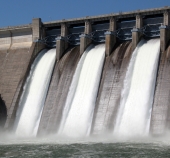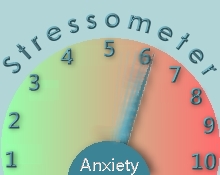Managing Your Stress to Avoid Panic Attacks
Stress is what we experience on the outside and anxiety is our internal response to that stress. A panic attack is a flood of fear in which normally-moderate physical and psychological reactions occur at extreme levels.
Stress is any situation that places demands on us or which is unfamiliar, or takes us outside of our comfort zone. So, any new experience is going to be somewhat stressful and the degree of stress depends on how far outside our comfort zone we are going.
Remember, life itself is inherently stressful; dealing with children, queuing in traffic, a busy supermarket, an irate boss, too much work or a deadline that is hard to meet -- all of these are stressful. In addition, life also throws at us those occasional or unusual events like moving house, losing your job, the ending of a relationship, illness in yourself or a loved one or a death in the family.

Stress is what happens on the outside and Anxiety is our response
If you experience panic attacks, it is in response to stress/anxiety. So, is important to first of all become aware of your general level of stress or anxiety.

It is important to monitor and manage your stress level because when it is high, it needs only a little extra stress to put you at risk of going into panic
We are all subject to a certain amount of stress all the time. Stress is cumulative -- it adds up -- and so far as panic attacks are concerned, the source of this stress is less important than the overall level.
Stress and our internal response to it -- anxiety -- accumulates. It's a bit like a reservoir; imagine the water in the reservoir is your stress/anxiety level.
 Stress accumulates; like water in a reservoir it is continually "topped up"
Stress accumulates; like water in a reservoir it is continually "topped up"
Water is continually pouring into it from various sources; some are small streams continually trickling into the reservoir -- typically the everyday stress that affects us all as we live our lives.
There are also torrents -- a flood of stress from sudden or unusual life changes, or our overreaction to more normal events if we have been over-sensitised to anxiety because of longer term exposure.
 The best way to deal with this continual accumulation of stress is the same way that it is dealt with in a real reservoir.
The best way to deal with this continual accumulation of stress is the same way that it is dealt with in a real reservoir.
When water accumulated in the reservoir reaches full capacity, some is released
Once the water level reaches design limits, channels are opened up which allow the water to escape. This safely reduces stress on the dam wall, enabling it to function normally throughout a long life. At times when lots of water is rushing into the reservoir, water will continually also be pouring out of it, maintaining a healthy balance.
In our lives, the equivalent of this is activity that reverses the effects of adrenaline, calming the mind and body, easing tension, helping us rebuild energy, helping us to sleep, promoting recovery and boosting the immune system. Exercise, even low intensity exercise like walking, achieves this. Meditation, massage, breathing exercises and something called progressive muscle relaxation are also highly effective examples. There is more detail about relaxation exercises in a separate document “Relaxation Techniques”.
 Left unchecked, the level of accumulated stress overwhelms your capacity to cope. Huge quantities of anxiety overflow. There's enormous energy in this -- it's a panic attack, an out-of-control release of emotion and fear -- our internal response to external stress.
Left unchecked, the level of accumulated stress overwhelms your capacity to cope. Huge quantities of anxiety overflow. There's enormous energy in this -- it's a panic attack, an out-of-control release of emotion and fear -- our internal response to external stress.
A flood of stress and anxiety, if not released, can burst out and cause a terrifying cascade of symptoms
It doesn't actually cause any damage as such but in the moment it is happening, it feels like it is going to do. Panic attacks are, by their nature, terrifying. The thing to remember is that, when you are “full to the brim” with stress, it takes only one more drop to cause a flood. That “last drop” can be anything, even something trivial. Back to top of page
Preventing Panic Attacks
The best way to deal with a panic attack is to prevent it from happening in the first place. If you are aware of your level of stress, you know when it is important to consciously manage it down using relaxation, breathing techniques or exercise.
Get used to monitoring your stress, taking time several times a day to consciously become aware of what level you are at. I usually suggest a scale of one to 10 and suggest to clients that they look out for the signs of stress like, for example, stiff shoulders, muscular tension, poor concentration, a sense of losing control or feeling overwhelmed etc. You need to "calibrate" your own scale so that you can quickly learn what a 4, a 7 or a 9 feels like (for example) and then take appropriate action to get that number down before it gets too high.

What's your number? The best way to avoid a panic is to monitor and then take control of, your anxiety level. Keep it low to avoid further attacks
This anxiety scale is the basis of lots of the work that I do with my clients: once they have become used to the idea of the scale, I ask them to keep a diary, linking specific events to scores and then later to thought processes and behaviour around specific events. This helps them to understand where their stress is arising and how they may be maintaining or even increasing their anxiety by their thoughts and their behavioural responses.
This approach becomes the basis of helping them to adopt new and healthier ways of dealing with stress and ultimately leads to the goal of reducing their anxiety, removing the risk of further panic attacks for good. But what happens if you experience an attack in spite of these measures? Back to top of page
Previous Page: What Is a Panic Attack?
Next Page: Dealing with Panic Attacks if they happen
